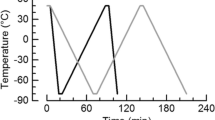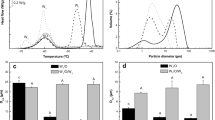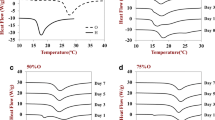Abstract
Water in oil in water (WOW) double emulsions are of great interest for the encapsulation of valuable substances. Nevertheless, the stabilization against inner water loss is still a challenging issue that impedes systematical research on the impact of the formulation. One common and applied technique to characterize the amount of inner water encapsulated in double emulsions is based on differential scanning calorimetry (DSC). Thereby, WOW double emulsions are frozen and thawed according to a defined method and afterward the amount of encapsulated water is calculated based on the DSC measurement result. For systematical investigations on the formulations’ impact on the encapsulation efficiency (EE), structure stability during this freezing and thawing procedure is required to be independent of formulation changes, whereby the EE is defined as the ratio between the amount of inner water after a specific time and the initial amount of water used for preparation of the double emulsion. In this study, we focused on the structural stability of double emulsions during their characterization by DSC. We prepared WOW double emulsions with varied formulations and characterized them considering inner and outer droplet size distribution (laser diffraction), microstructure (microscope), and EE (DSC). In some cases, the EE values determined by DSC were not reproducible and contradicted microscopic pictures and measured droplet size distributions. By using a polarizing microscope with temperature-controlled sample chamber, structure changes during the freezing and thawing procedure could be observed. Contact-induced crystallization, water diffusion as well as the spread of the phase transition temperature are discussed as reasons for the barely reproducible and sometimes contradictory results. Based on our findings, it is recommended for further studies on double emulsions to examine the structure stability during the DSC measurements.







Similar content being viewed by others
References
McClements DJ. Encapsulation, protection, and release of hydrophilic active components: potential and limitations of colloidal delivery systems. Adv Colloid Interface Sci. 2015;219:27–53.
Garti N, Bisperink C. Double emulsions: progress and applications. Curr Opin Colloid Interface Sci. 1998;3:657–67.
Muschiolik G, Dickinson E. Double emulsions relevant to food systems: preparation, stability, and applications. Compr Rev Food Sci Food Saf. 2017;16(3):532–55.
Dickinson E. Double emulsions stabilized by food biopolymers. Food Biophys. 2011;6:1–11.
Ficheux MF, Bonakdar L, Leal-Calderon F, Bibette J. Some stability criteria for double emulsions. Langmuir. 1998;14:2702–6.
Pays K, Giermanska-Kahn J, Pouligny B, Bibette J, Leal-Calderon F. Double emulsions: how does release occur? J Control Release. 2002;79:193–205.
Garti N, Aserin A. Double emulsions stabilized by macromolecular surfactants. Adv Colloid Interface Sci. 1996;65:37–69.
Gülseren İ, Corredig M. Interactions at the interface between hydrophobic and hydrophilic emulsifiers: polyglycerol polyricinoleate (PGPR) and milk proteins, studied by drop shape tensiometry. Food Hydrocoll. 2012;29:193–8.
Rosano HL, Gandolfo FG, Hidrot JDP. Stability of W1/O/W2 multiple emulsions—influence of ripening and interfacial interactions. Colloids Surf A Physicochem Eng Asp. 1998;138:109–21.
Cindio Bd, Grasso G, Cacace D. Water-in-oil-in-water double emulsions for food applications: yield analysis and rheological properties. Food Hydrocoll. 1991;4:339–53.
Schuch A, Köhler K, Schuchmann HP. Differential scanning calorimetry (DSC) in multiple W/O/W emulsions. J Therm Anal Calorim. 2013;111:1881–90.
Kovacs A, Csoka I, Konya M, Csanyi E, Feher A, Eros I. Structural analysis of w/o/w multiple emulsions by means of DSC. J Therm Anal Calorim. 2005;82:491–7.
Schuch A, Tonay AN, Köhler K, Schuchmann HP. Influence of the second emulsification step during production of W/O/W multiple emulsions: comparison of different methods to determine encapsulation efficiency in W/O/W emulsions. Can J Chem Eng. 2014;92:203–9.
Schuch A, Helfenritter C, Funck M, Schuchmann HP. Observations on the influence of different biopolymers on coalescence of inner water droplets in W/O/W (water-in-oil-in-water) double emulsions. Colloids Surf A. 2015;475:2–8.
Oppermann A, Renssen M, Schuch A, Stieger M, Scholten E. Effect of gelation of inner dispersed phase on stability of (w1/o/w2) multiple emulsions. Food Hydrocoll. 2015;48:17–26.
Potier L, Raynal S, Seiller M, Grossiord JL, Clausse D. Study of state transitions within multiple W/O/W emulsions using calorimetry (Dsc). Thermochim Acta. 1992;204:145–55.
Clausse D. Thermal behaviour of emulsions studied by differential scanning calorimetry. J Therm Anal Calorim. 1998;51:191–201.
Clausse D, Pezron I, Komunjer L. Stability of W/O and W/O/W emulsions as a result of partial solidification. Colloids Surf A Physicochem Eng Asp. 1999;152:23–9.
Schuch A, Wrenger J, Schuchmann HP. Production of W/O/W double emulsions: part II: influence of emulsification device on release of water by coalescence. Colloids Surf A Physicochem Eng Asp. 2014;461:344–51.
Vanapalli SA, Coupland JN. Emulsions under shear—the formation and properties of partially coalesced lipid structures. Food Hydrocoll. 2001;15:507–12.
Acknowledgements
This research project was supported by the German Ministry of Economics and Energy (via Arbeitsgemeinschaft industrieller Forschungsvereinigungen AiF “Otto von Guericke” e.V.) and GVT (Forschungs-Gesellschaft Verfahrens-Technik e.V., Frankfurt/Main) in the scope of project AiF 19443 N. Further, the authors would like to express their thanks to Lydia Schütz, Jana Usselmann, Lisa Kagerbauer, and Manuela Sevilla for supporting the experiments.
Author information
Authors and Affiliations
Corresponding author
Rights and permissions
About this article
Cite this article
Neumann, S.M., van der Schaaf, U.S. & Karbstein, H.P. Structure stability and crystallization behavior of water in oil in water (WOW) double emulsions during their characterization by differential scanning calorimetry (DSC). J Therm Anal Calorim 133, 1499–1508 (2018). https://doi.org/10.1007/s10973-017-6723-4
Received:
Accepted:
Published:
Issue Date:
DOI: https://doi.org/10.1007/s10973-017-6723-4




